
Gini Varghese is running for one of the two open Hillsdale seats. The other candidates running for the two open Hillsdale seats are Arnold Scher (incumbent), Kristin Martin, and Pat Luisi.
The daughter of immigrant parents, Varghese grew up in Teaneck and has lived in Hillsdale for 13 years with her husband and two kids. She earned a Bachelor’s in Psychology from New York University and a second Bachelor’s in Nursing and a Masters in Science as a nurse practitioner, an occupation she has held over 20 years. Varghese has also been a Girl Scout troop leader, a youth sports coach, a class parent, and a corresponding secretary and co-chair of the book fair of the George White Faculty and Family Association.
Varghese has centered her campaign around student and teacher wellness during the Covid-19 pandemic. She has emphasized the need for an engaged listener on the Board who, as the mother of a freshman daughter at Valley and a son in middle school, has a personal investment in the success of the district.
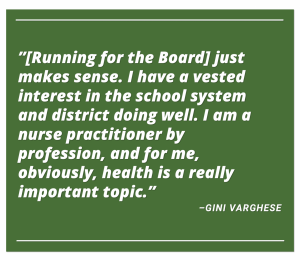 Why Varghese is running
Why Varghese is running
This school year is Varghese’s daughter’s first at Valley. Varghese argues that this gives her a “vested interest in the school system and district doing well.”
She named two main priorities as a candidate for the Board: a focus on health and safety during Covid-19 and “greater community outreach.”
“I am a nurse practitioner by profession,” Varghese explained, “and for me, obviously, health is a really important topic.” She argued the Board needs to continue to focus on keeping students and staff safe from Covid-19.
Citing her experience in the medical field, Varghese professed that “what we have to do is concentrate on maintaining in-person instruction, which I believe to be the best way for students to learn.” She countered this by explaining that the pandemic is a dynamic, “day-to-day” issue which means available information “needs to be reassessed on a daily basis.”
Her second main reason for running, Varghese stressed the need for “an open line of communication and to maintain that between the Board and the community.”
Read full response
Jared Mitovich: This year has been extremely hectic because of the pandemic and a lot of other things. What motivates you to become a Board member now, and what will be your top priorities if elected?
Gini Varghese: My motivation is that my daughter is now a freshman at Valley, and I have always been involved with different things in elementary school and middle school. Of course, as you get to the high school level, the opportunities are less [for a parent] to sort of make an impact with the kids. I‘ve always wanted to be someone who is involved with my kids’ school, I just felt like this was sort of the perfect time, because my daughter will be [at Valley] for four years, but then my son will be [at Valley] in three years. For me, it just makes sense. I have a vested interest in the school system and district doing well.
I am a nurse practitioner by profession, and for me, obviously, health is a really important topic. I have a lot to contribute, because I am a nurse practitioner in primary care, so it’s going to be the healthcare that matters the most. Priorities change with the times, and right now our priorities are going to be around Covid-19 and getting back to focusing on the health and safety for students and the teachers. What we have to do is concentrate on maintaining in-person instruction, which I believe to be the best way for students to learn, while making the safety of teachers and students the priority during a health crisis. It’s a dynamic issue, so it can change day-to-day. Since the Covid-19 pandemic started, every day at work we were getting different information. We were getting updates every day, and so all of the information as far as in school also needs to be reassessed on a daily basis.
The other thing I would like to focus on is greater community outreach by the Board –– to have an open line of communication and to maintain that between the Board and the community. Outreach is really important.
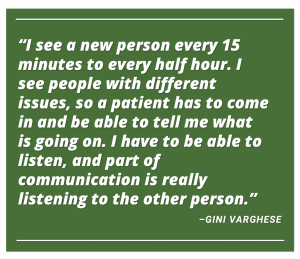 On the Board’s goal to improve communication
On the Board’s goal to improve communication
The issue of communication has been debated among the community the past few months, and it has become a focus of the Board this school year as well –– one of its goals is to “[e]stablish a Board of Education communications committee. Plan for more frequent communications from the board, including a board specific newsletter to the community regarding reopening and the operations” of the Board of Education.
When pressed on whether this was a current fault of the Board or only an area to focus on, Varghese said, “I consider myself to be a lifelong learner, so I am really one of those people that feels like there’s always room for improvement and for betterment.”
“I think that, especially in the digital age, there’s so many ways of communicating with other people,” she continued. “To me just as a person, I’m really big on communication –– like being able to get your point across in a way that people can understand.”
Read full response
JM: That is one of the Board’s goals for this year: to improve communications between the community and the Board itself. You said you want to improve it, but do you see the current status of communication as a fault? Do you see any examples of it being a fault, or are you mainly focused on improving it?
GV: I consider myself to be a lifelong learner, so I am really one of those people that feels like there’s always room for improvement and for betterment. I think that, especially in the digital age, there’s so many ways of communicating with other people. To me just as a person, I’m really big on communication –– like being able to get your point across in a way that people can understand. I think that regardless of whether it was even a very great system, there’s always something that can be improved.
Varghese said she formed this philosophy from seeing “a new person every 15 minutes to half an hour” as a nurse practitioner in primary care. “I have to be able to listen, and part of communication is really listening to the other person. I have to be able to get my point across to the other person in a way that they’ll understand.”
While she did not provide specific policies surrounding communication, Varghese indicated she is capable of working with students with “different kinds of personalities” as well as “different kinds of people.”
Read full response
JM: Have you realized what you describe as the importance of communication from your experience in the workforce? How has your perspective been shaped by your experiences?
GV: At work, I see a new person every 15 minutes to every half hour. I see people with different issues, so a patient has to come in and be able to tell me what is going on. I have to be able to listen, and part of communication is really listening to the other person. I have to be able to get my point across to the other person in a way that they’ll understand.
I feel like I have a lot of experience with different kinds of personalities and different kinds of people. Sometimes, you get people with a shell, and it’s hard to crack that shell or break that wall. I think having someone who’s used to dealing with different kinds of people is a really good thing and communication is very important to me. And I have to say that wearing masks has been tough, because I use a lot of body language and facial expressions when I assess people as I’m speaking –– how they’re responding to things –– and I can’t do that anymore because I can’t tell if they’re smiling or not. I have to say it has been more challenging because of that.
JM: From being in school, I can never truly tell who’s smiling or not.
GV: Do you ever feel like you’re losing your hearing? When I maybe wouldn’t hear something clearly, I would look at someone’s lips and I would lip read. Now all of a sudden, I don’t have that anymore, so I feel like I’m losing my hearing but really the understanding of how people are communicating.
JM: The lack of such an important part of communication.
GV: We don’t realize it until we lose that. So I just really feel like communication is very important.
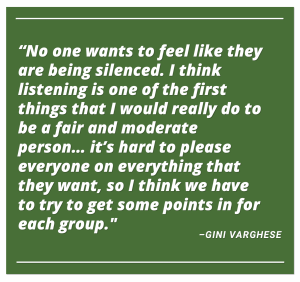 On bringing a divided community together
On bringing a divided community together
Varghese, who has described herself as a “fair and moderate” thinker, would join the Board at a time when its reputation has been defined in part by its unanimous vote to remove the Cowboy and Indian mascots.
“No one wants to feel like they are being silenced,” Varghese said, speaking to objections by some community members that the Board had not taken their voices into account when taking the mascot vote. “Listening is one of the first things that I would really do to be a fair and moderate person.”
The mascot removal was not the only issue where parents had differing opinions about what was best for their students –– or for the advancement of their beliefs. Over the summer, there were also debates about the district’s handling of a Black Lives Matter sign placed in front of school and how much time students should be in-school per week.
“I’d want to kind of take sort of the middle ground and work with that,” said Varghese about handling two sides of an issue. “I think it’s hard to please everyone on everything they want, so I think we have to try to get some points in for each group.”
Read full response
JM: I want to touch on that a little bit more, because the Board’s communications have been debated. On your campaign Facebook, you say you have a way of thinking that is “fair and moderate”. How would you apply this “fair and moderate” philosophy to bringing a somewhat still-divided community around new mascots, the result of a vote met by vitriol for and against it?
GV: First, we have to listen. Being fair and moderate –– unless you know someone’s position, you cannot apply fairness to a decision that’s going to be made. You really do have to listen, and I think people want to be heard. No one wants to feel like they are being silenced. Listening is one of the first things that I would really do to be a fair and moderate person.
To me, I think there needs to be a middle ground if you’re having different groups. I think you have to be able to work with each group and see where they are. There’s a lot of give and take with all this sort of thing, so I just sort of feel like I’d want to listen, and then I’d want to kind of take sort of the middle ground and work with that.
I think it’s hard to please everyone on everything that they want, so I think we have to try to get some points in for each group.
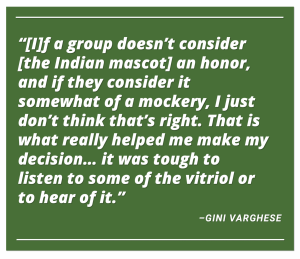 On the mascot removal
On the mascot removal
In terms of the reaction to the removal, Varghese said “it was very passionate,” but that it was “tough to listen to some of the vitriol or to hear of it.”
She said she made her own personal decision in favor of removing the Indian mascot from doing her own research of the Lenape Indians, the local Native American tribe.
“They had a whole page of why they don’t feel that it is an honor for their likeness or their name to be used,” Varghese recalled.”My reaction was that if a group doesn’t consider it an honor, and if they consider it somewhat of a mockery, I just don’t think that’s right.”
[Editor’s note: For more on the history of the likeness of Cowboys and Indians being used as mascots, click here.]
Read full response
JM: There are Board candidates who have vocal positions about if the mascot vote and reaction was positive or negative and how they would seek to move forward on the removal as a member. What is your perspective on the mascot decision, positive or negative? Do you see the community’s reaction as positive or negative?
GV: In terms of the decision itself: First, I didn’t understand what the major issue was with repealing [the Indian mascot]. I didn’t realize this was something that has been talked about for so many years and been in the works.
At the same time, when I went on to the Lenape Indian website –– the local Native American tribe –– I went onto their website and it said why they were against mascots. They have a whole page of why they don’t feel that it is an honor for their likeness or their name to be used. My reaction was that if a group doesn’t consider it an honor, and if they consider it somewhat of a mockery, I just don’t think that’s right. That is what really helped me make my decision.
In terms of the response to it, I think it was very passionate. I do think that it was tough to listen to some of the vitriol or to hear of it. That is all I am going to say on that.
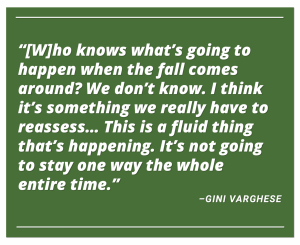 On the reopening of school and Covid-19 safety
On the reopening of school and Covid-19 safety
Varghese is currently in favor of the hybrid instructional plan, which has been implemented for over a month at both Hills and Valley.
“I feel that of course, being in school is the best way to learn for many reasons: [Students are] in front of a teacher, you have your classmates around you, you are in a different environment –– environment is huge,” she explained.
Still, Varghese said she understood parents’ and teachers’ remaining concerns about keeping themselves and their families safe, describing them as “valid.”
“We’re not just talking about a cold here –– you can get really sick, and there can definitely be lots of repercussions associated with being sick,” Varghese pointed out.
Emphasizing flexibility and grace in relation to current health conditions and recommendations, Varghese forewarned that “we don’t know” what will happen as the school year progresses.
Read full response
JM: I want to focus a bit on the reopening of school. You’re a parent, you’ve got a Valley student, this is a very important area to talk about. You mentioned you’re in favor of in-person instruction or I’m assuming the current plan?
GV: Yes, the current plan.
JM: According to Superintendent Erik Gundersen, 10% of students are learning all- virtual right now. Some parents are concerned about their child[ren]’s wellbeing, whether it be mental health or safety in general. This has also been voiced by teachers’ unions in the area, even though they’ve been largely addressed at our school according to the Board. What do you see as the biggest area of improvement in this reopening plan, and do you see these parents’ and teachers’ concerns?
GV: 100%. This is a really difficult issue, because you’re trying to balance people’s physical health with their mental health. The lines between a lot of issues can get blurred –– between these two things also.
When we’re talking about physical health, sometimes people think that the thought of their physical health affects their mental health. I feel that of course, being in school is the best way to learn for many reasons: [Students are] in front of a teacher, you have your classmates around you, you are in a different environment –– environment is huge. So yes, that is the ideal way.
At the same time, I feel like it’s a daily changing thing –– maybe not necessarily daily changing now, but at a certain point who knows what’s going to happen when the fall comes around? We don’t know. I think it’s something we really have to reassess.
As far as people being afraid for their children or teachers, I think it’s a valid concern. We’re not just talking about a cold here –– you can get really sick, and there can definitely be lots of repercussions associated with being sick. The physical part is a valid concern.
Every parent has to do what they feel is best for their children. I would never presume to tell someone you should be doing this or that. I think we’re all doing our best, and we all have to have some sort of grace and kindness with each other in the sense that, “Okay, you made that decision; that’s fine.”
For the teachers, I think that it also has to be on a case-by-case basis. Again: This is a fluid thing that’s happening. It’s not going to stay one way the whole entire time, and “Hey, we made the decision and that’s the way it’s going to be.” It’s going to have to be, “Okay, we made this decision; this is what’s working and this is what’s not.” So it needs to be assessed that way, and at the same time, everything can change outside in the real world. There’s a lot of just being flexible in relation to that.
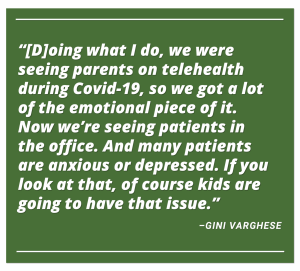 On student wellness
On student wellness
“[W]e were seeing parents on telehealth during Covid-19, so we got a lot of the emotional piece of it. Now we’re seeing patients in the office. And many patients are anxious or depressed,” Varghese explained. “If you look at that, of course kids are going to have that issue.”
Because of what she described as “a lot” changing for students very quickly as a result of the pandemic, Varghese said as a Bord member she would want to place more focus on the Wellness Center, a Valley initiative to provide service and support to students struggling with their mental health.
“I’m just seeing it in my everyday practice,” Varghese said.
Read full response
JM: The last candidate I interviewed, incumbent Arnold Scher, is also running for one of the Hillsdale seats. He spoke about how one of his priorities is to focus on the Wellness Center. Are you familiar with the Wellness Center, and is that something you’d also want to divest attention to if elected and work with him on if you both get the seats?
GV: I have to tell you that doing what I do, we were seeing parents on telehealth during Covid-19, so we got a lot of the emotional piece of it. Now we’re seeing patients in the office. And many patients are anxious or depressed.
If you look at that, of course kids are going to have that issue. A lot changed for you guys overnight –– just like everybody else –– and I feel like as young people, sometimes it’s harder to come to terms with that change. You guys are looking to branch out and do your own thing away from your parents, and all of a sudden it’s like you have to stay home and be stuck with your parents. Not necessarily in a bad way but you’re in this house, and I think things change. People’s mental states change. Friendships change. Kids who are very used to doing sports and they didn’t get to do it, that’s difficult. Kids who are very social kids. I think there is going to be a lot of repercussions from that, because even just the simple fact: If adults are feeling this, of course it’s going to trickle down to their children. I do agree with Mr. Scher that that is going to be something that really does need to be emphasized more. Because I’m just seeing it in my everyday practice.
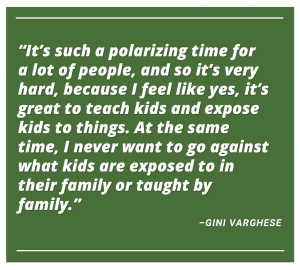 On inclusivity and equity
On inclusivity and equity
One part of inclusivity Varghese said she would focus on as a Board member is making sure the 10% of students learning entirely remotely feel that their needs are met. “That’s a different part of inclusivity that we haven’t had until now,” she pointed out.
Turning to her background as the daughter of immigrants, Varghese said growing up in Teaneck allowed her to see “every sort of culture and religion.”
While she emphasized that being exposed to similar diversity “does help,” Varghese argued that issues of inclusivity and equity are polarizing.
“At the same time, I never want to go against what kids are exposed to in their family or taught by family. I wouldn’t want those two things to be at odds. So that’s a tough question to answer,” she said.
Read full response
JM: One of the district’s goals is to “Advance the work of inclusivity and equity throughout the district. Incorporating data-driven research into equity education for faculty, collaborative efforts with community and regional partners, curriculum development, and leadership and goal setting.”
You are the daughter of immigrant parents. What is your experience with inclusivity and equity, and what do you think our district can do to increase equitable practices?
GV: I grew up in Teaneck, which is a really diverse place. There was every sort of culture and religion; it was a great way to grow up having that diversity.
When I read the Board goals for the interview I was like, “inclusivity, wow,” because I know one part of this is pertaining to Covid-19. There’s those 10% of kids that are still at home doing remote learning, and it’s very isolating. I think that’s a different part of inclusivity that we haven’t had until now, and we definitely have to work with those kids.
I think we as adults also need to give credit to kids. You guys grew up in the digital age; you see so many more things than [we adults] ever did in our lives. I think as far as being inclusive, the biggest thing that I teach my kids is that no matter how different someone is from you, you just be kind. I think if we can sometimes be exposed to different cultures or that sort of thing, it does help.
It’s tough, it’s a tough question to answer especially in this time when there is so much upheaval from so many different issues at this point. I feel like with the inclusivity thing, I think all the school can do is –– I don’t know, that’s a really tough question.
JM: I was trying to see what you were thinking about inclusivity, and you answered that question.
GV: It’s tough. It’s such a polarizing issue. It’s such a polarizing time for a lot of people, and so it’s very hard, because I feel like yes, it’s great to teach kids and expose kids to things. At the same time, I never want to go against what kids are exposed to in their family or taught by family. I wouldn’t want those two things to be at odds. So that’s a tough question to answer.
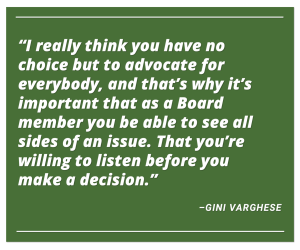 On Board members’ advocacy and responsibilities
On Board members’ advocacy and responsibilities
“[Being a Board member is] not a position that you can just look at and say, ‘well, from the student perspective,’ or ‘from the teacher’s perspective,’ or “from the community perspective,” said Varghese, who has also been a Girl Scout troop leader and a co-chair of the book fair of the George White Faculty and Family Association. “You have a responsibility to sort of put all these things together. It’s not an easy feat, especially when there are times of differing opinions… Advocacy has to happen for everybody.”
Read full response
JM: What responsibilities do Board members have regarding advocacy –– for certain issues, for certain students, or for certain groups of students?
GV: If you’re a Board member, you should be advocating for students first and foremost, but teachers also and the community. It’s not a position that you can just look at and say, “well, from the student perspective,” or “from the teacher’s perspective,” or “from the community perspective.” As a Board member, you have a responsibility to sort of put all these things together. It’s not an easy feat, especially when there are times of differing opinions. It’s not an easy feat. Advocacy has to happen for everybody.
Of course students are the priority, but teachers are too because, say we’re talking about health, that makes a huge difference. I really think you have no choice but to advocate for everybody, and that’s why it’s important that as a Board member you be able to see all sides of an issue. That you’re willing to listen before you make a decision.
Returning to her campaign’s theme of listening to different sides of an issue, Varghese said doing so allows Board members to come up with solutions to problems that address everyone’s interests.
She explained, “I tell my patients all the time, ‘This is a me and you decision.’ This is not me just looking at you and saying, ‘Alright, you’re going to get a CAT scan. That’s it.’ It’s more like, ‘Oh, okay. So a CAT scan bothers you because you’re worried about radiation. I can understand that. How about we do this test that doesn’t have radiation, and if that doesn’t tell us anything we can go here.”
“I am a good listener, and I can formulate a plan based on those concerns and issues that people have,” Varghese said.
Read full response
JM: As you mentioned, I’ve talked to many all-virtual students, and several shared the same idea you described: Some sense that, even if they are on the Google Meet, they still feel left out because they’re surrounded by the four walls of their home and not the school.
In the same vein of advocacy, some students and parents felt left out by certain decisions such as the mascot decision and regarding gender equity. There were kids and parents who were protesting, who may have disagreed with some of the reopening details. Do you think you’re prepared to tackle these divisions in our community? How would you bring the community together?
GV: I really think the first thing you have to do is listen to people. People just want to be heard. People want that, “Okay, this is why this bothers me or that bothers me. These are the reasons.” If you really listen to people, you can then say, “Okay, so how about if you come up with this solution or this problem, we’re going to solve it this way, and we’re going to work with what you gave us and maybe what we have to do or what this other group wants or other person wants.”
Again, my living is listening to people and then having to make a decision on what to do. I do not have a problem listening, and then I try to make the decision that would be made working together. I tell my patients all the time, “This is a me and you decision.” This is not me just looking at you and saying, “Alright, you’re going to get a CAT scan. That’s it.’” It’s more like, “Oh, okay. So a CAT scan bothers you because you’re worried about radiation. I can understand that. How about we do this test that doesn’t have radiation, and if that doesn’t tell us anything we can go here.”
Listening is the first thing, but I think trying to work with those concerns and issues really is the second. I am a good listener, and I can formulate a plan based on those concerns and issues that people have.
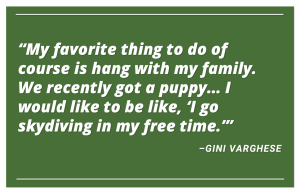 On her favorite pastimes
On her favorite pastimes
“I would like to be like, ‘I go skydiving in my free time,'” confessed Varghese. Her favorite pastimes including hanging out with her family and their new puppy, going to the gym, reading, and cooking.
Reflecting on the many years of 2020, Varghese said she was able to get to know her neighbors better while New Jersey was shut down in the spring. “[O]bviously not counting all the fatalities and the people getting really ill… you had to slow down and be with each other,” she said.
Now several months later, as Varghese and other parents send their kids back to school, she wants the community to know that she “would listen to all sides before I make my decision.”
Read full response
JM: Outside of running for the Board, what do you like to do in your free time?
GV: My favorite thing to do of course is hang with my family. We recently got a puppy –– she is amazing. We’ve been spending a lot of time with her. I am definitely health-conscious; I do like going to the gym. I love to read. I don’t have as much time. I like to cook. I sound kind of boring.
JM: I totally see all your interests.
GV: It’s like, wait a second, what exciting thing? I would like to be like, “I go skydiving in my free time.”
JM: No candidate is going to have an answer as cool as skydiving.
GV: You have to tell me if someone says they do that. But going to the gym, spending time with my family, reading and cooking. And gardening.
JM: I think 2020 has made us boring. Well, not boring –– it’s just like it limits our ability to do things that are exciting.
GV: I have to tell you that it actually has not been a bad thing. If you asked me in January of February, when we’re running around, we’re going from this sport to do this, to do that. Then all of a sudden –– obviously not counting all the fatalities and the people getting really ill –– you had to slow down and be with each other. A lot of people cooked meals because the restaurants were not open. You had time to read a little bit.
We ended up meeting our neighbors. We always knew our neighbors, and we’d say hello and chat here and there, but you’re so busy running out of your house that you never really had time to spend with them. So now just doing walks and all of that, we got to know our neighbors a lot better. I think there’s a lot of human things that have come out from the pandemic. There’s not really anyone I’ve talked to that has been telling me anything exciting, because no one’s traveling –– or barely.
JM: Anything you’d like to add or follow up on from our conversation?
GV: I just think being on the Board is a privilege, and it is an honor. I think I would listen to all sides before I make my decision, and I think that it helps to be able to be somebody who can listen.
Read another profile:
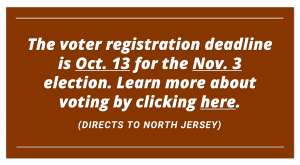
 Why Varghese is running
Why Varghese is running On the Board’s goal to improve communication
On the Board’s goal to improve communication On bringing a divided community together
On bringing a divided community together On the mascot removal
On the mascot removal On the reopening of school and Covid-19 safety
On the reopening of school and Covid-19 safety On student wellness
On student wellness On inclusivity and equity
On inclusivity and equity On Board members’ advocacy and responsibilities
On Board members’ advocacy and responsibilities On her favorite pastimes
On her favorite pastimes

